Odds Of Having A Child With Autism By Age

Exploring the Complex Relationship Between Age and Autism Spectrum Disorder
Recent research highlights the significant influence of parental age at conception on the likelihood of autism spectrum disorder (ASD) in children. While genetic and environmental factors also play vital roles, the age of both mothers and fathers has emerged as an important risk factor. This article delves into the statistical data, scientific explanations, and broader implications behind the connection between parental age and autism, providing a comprehensive overview for readers interested in understanding this multifaceted issue.
The Influence of Paternal Age on Autism Risk
Are the odds of autism affected by age at conception?
Research consistently shows that parental age at conception plays a significant role in the likelihood of autism spectrum disorder (ASD) in children. Both maternal and paternal ages influence the risk, but the impact of paternal age appears particularly notable.
For mothers, the risk of having a child with autism increases after the age of 35, with studies indicating a sharp rise in risk for women aged 40 and above. For fathers, the effect is more linear and steady across their lifespan. Men over 55, for example, are four times more likely to father a child with autism than men under 30.
Younger parents, particularly mothers aged 15 to 21, tend to have a lower risk of having children with autism compared to those in their early 30s. Overall, parental age at conception is a significant factor, with older parental age associated with a higher likelihood of autism.
Biologically, this increased risk is thought to stem from genetic and epigenetic changes accumulated over time. Older men pass on more mutations through sperm, which can contribute to neurodevelopmental differences such as autism.
What is the relationship between parental age and autism risk?
The link between parental age and autism risk has been supported by multiple large-scale studies across different populations. Data from Danish and Swedish registries, comprising nearly 1.5 million children, show that children born to fathers over 40 to 55 have up to a 50% higher chance of developing autism compared to those with younger fathers.
Specifically, children of fathers in their 30s have about a 10% higher chance of ASD than children of fathers in their 20s. The risk increases further as paternal age advances: men over 55 are four times more likely to have children with autism than men under 30.
While maternal age also influences risk, the pattern is less clear. Some studies suggest an increase in autism risk after age 30 for mothers, with the risk rising sharply beyond that age. Interestingly, some research indicates that very young maternal age might also be associated with increased risk, adding complexity to the relationship.
This dose-dependent relationship is believed to be driven primarily by the accumulation of spontaneous, or de novo, mutations in the sperm that occur as men age. These mutations can interfere with neurodevelopment, increasing the likelihood of autism.
Overall, parental age at conception accounts for approximately 1 to 5% of the rise in autism prevalence, acting as one of several factors contributing to the trend. Understanding this relationship highlights the importance of biological factors such as genetic mutations and epigenetics, which evolve with age and influence neurodevelopmental outcomes.
Genetic Underpinnings of Autism
What are the genetic factors involved in autism?
Genetics substantially influence the development of autism spectrum disorder (ASD). According to twin studies, heritability estimates often range from 76% to 90%, highlighting a strong genetic component. A Swedish cohort study, for instance, found that genetics account for about 69% to 87% of ASD risk, with environmental influences playing a smaller role.
Family histories reveal that having a sibling with autism significantly increases the likelihood of ASD, with recurrence rates of around 20-25%. When parents have autism, the probability of their children being affected is even higher. These familial patterns point to inherited genetic factors that elevate risk.
Key genes involved in ASD
Researchers have identified several genes linked to autism, especially those involved in neural development and synaptic functions. Some of the most studied genes include:
| Gene | Function | Impact on ASD |
|---|---|---|
| CHD8 | Chromatin remodeling, gene expression regulation | Mutations associated with autism and macrocephaly |
| SHANK3 | Synaptic scaffolding protein | Variants linked to ASD, particularly in Phelan-McDermid syndrome |
| PTEN | Cell growth regulation | Mutations often associated with autism and macrocephaly |
| NLGN3 | Neuroligin involved in synaptic adhesion | Variants linked to synaptic dysfunction in ASD |
| NLGN4 | Similar role to NLGN3 | Implicated in autism cases involving synaptic anomalies |
These genes are crucial as they influence brain development and communication pathways, which are often disrupted in ASD.
Role of genetic mutations and variants
A significant focus in autism research is on spontaneous mutations, known as de novo mutations, which occur during sperm formation. These mutations tend to accumulate more rapidly in men than women, partly explaining why advanced paternal age correlates with higher autism risk.
Older fathers pass on more genetic mutations, increasing the likelihood of de novo changes in their children. Studies indicate that men over 45 are approximately four times more likely to have a child with ASD than men under 30. Men in their 30s and 40s show increased risks too, with ages in the 40s and 50s raising a child's risk of ASD by about 50% compared to younger fathers.
While maternal age also affects autism risk, the association is less consistent. However, research from Danish and Swedish studies suggests that older maternal ages are linked to a higher probability of ASD, especially after age 30. Interestingly, some findings disclose that younger maternal age or grandparents' ages can also influence risk, hinting at complicated genetic and environmental interactions.
Overall, these mutations and genetic variations play a pivotal role in ASD development, often interacting with environmental factors to shape individual risk profiles.
| Factor | Effect | Age Range Impact | Explanation |
|---|---|---|---|
| De novo mutations | Spontaneous new mutations in sperm/egg | Men over 40, 50, or older | Accumulate faster in older fathers, raising mutation burden |
| Paternal age | Increase in genetic mutations | 30s to 50s | Older paternal age increases ASD risk due to mutation accumulation |
| Maternal age | Associated with increased risk | After 30 years | Slightly higher risk, though relationship is less clear |
Understanding these genetic influences furthers insight into ASD and highlights the complex interplay between inherited factors and new mutations.
The Role of Maternal Age in Autism Risk
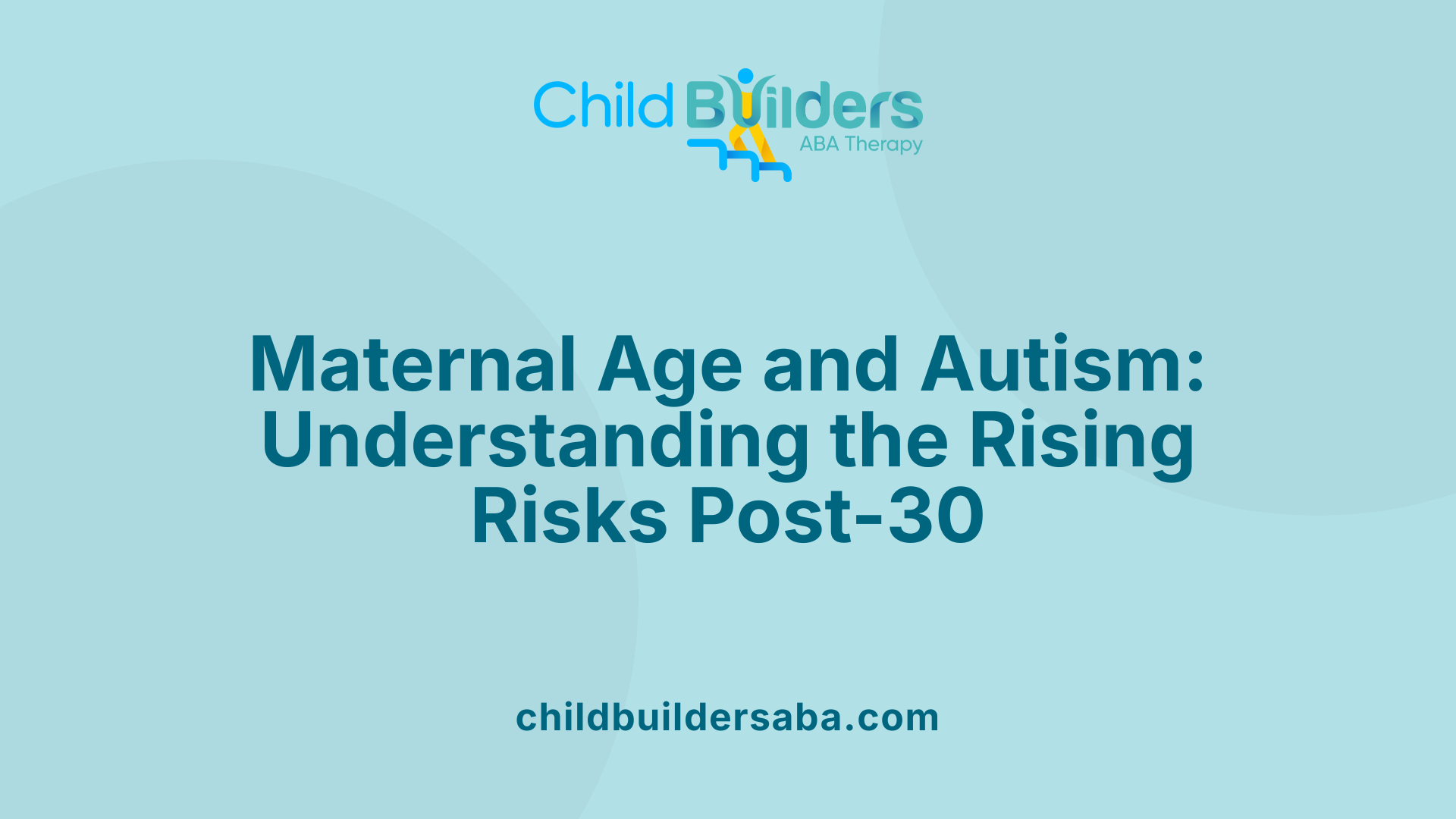
Impact of maternal age after 30
Research indicates that maternal age has a notable effect on the likelihood of autism spectrum disorder (ASD) in children, particularly after the age of 30. Studies reveal that for mothers under 30, the risk of ASD in their children remains relatively stable. However, once maternal age exceeds 30, the risk begins to increase more sharply.
Specifically, for mothers aged 30 and older, the chances of having a child with ASD rise quickly. Women in their early 30s see a modest increase, but the risk becomes more significant as maternal age advances into the 40s and beyond. For example, the risk of ASD in children born to mothers in their 40s is approximately 50% higher compared to those in their late 20s.
This heightened risk pertains not only to maternal age itself but also potentially involves accumulated environmental and genetic factors that may influence fetal development.
Comparison of maternal and paternal age effects
It is important to compare the effects of maternal and paternal ages to fully understand the dynamics of ASD risk. While both parental ages impact risk levels, their influence and mechanisms differ.
For paternal age, the risk increases steadily with age, mainly due to the accumulation of spontaneous mutations in sperm over time. Men over 40 or 55 show a significantly increased likelihood—up to six times higher—of fathering a child with autism compared to younger men.
In contrast, maternal age shows a different pattern: minimal or no increased risk before age 30, but a notable rise after 30. The risk accelerates more rapidly after 35 or 40. Evidence suggests that the effect of paternal age may be more directly linked to genetic mutations, whereas maternal age could involve additional factors such as decreased oocyte quality or environmental exposures.
Data from large-scale studies, including those from Swedish and Danish health registries, highlight that paternal age's impact on ASD risk is linear and consistent, whereas maternal age's influence appears more threshold-dependent, with increased risk manifesting primarily after age 30.
Recent studies on maternal age and ASD
Recent research utilizing extensive population data offers some clarity on the role of maternal age. A notable Swedish study, analyzing over 400,000 births, found that maternal age over 30 correlates with a growing risk of ASD. The study indicates that, while younger maternal age (<30) does not significantly raise ASD risk, risk increases substantially when maternal age surpasses 30.
Similarly, a Danish study involving nearly 1.5 million children uncovered that children born when their mothers were 30 or older had a higher probability of ASD diagnosis. The study also noted that this risk continues to grow with maternal age, especially after 35.
Interestingly, the research indicated no strong evidence of increased ASD risk among children of younger mothers under 20, but rather a consistent rise linked to maternal age after 30. This trend correlates with the broader understanding that genetic and environmental factors associated with older maternal age may contribute to increased neurodevelopmental risks.
This growing body of evidence highlights the importance of considering both parental ages when assessing ASD risk. Although the overall risk remains relatively low—about 1 in 100 children overall—clinical awareness and early screening become crucial, particularly for older parents.
| Parental Age Group | ASD Risk Increase | Relative Risk | Additional Notes |
|---|---|---|---|
| Under 30 | Baseline | 1.0 | No significant increase |
| 30-34 | Slight increase | Up to 1.2x | Risk begins to rise |
| 35-39 | Moderate increase | Up to 1.5x | Notable risk increase |
| 40 and above | Significant increase | About 1.5 to 2x | Highest observed risk |
Understanding the impact of parental age, especially maternal age, helps inform prospective parents and healthcare providers about potential risks. Early intervention and careful monitoring can improve outcomes, highlighting the importance of awareness and targeted screening in pregnancies for older women.
Statistical Trends and Current Prevalence of Autism
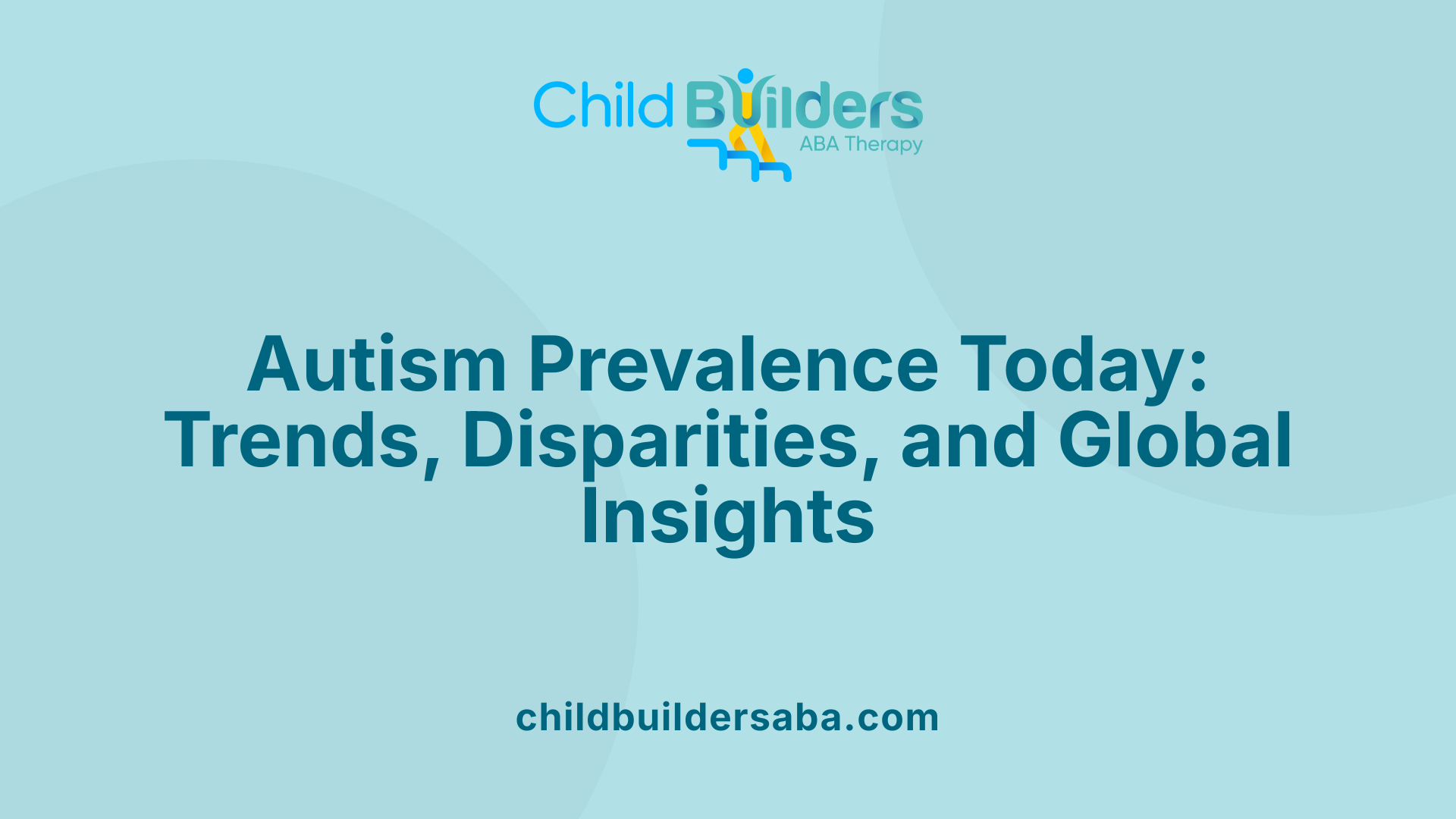
Autism prevalence rates in the U.S. and worldwide
Autism spectrum disorder (ASD) has become an increasingly recognized condition, affecting a significant portion of children around the world. In the United States, recent estimates reveal that about 1 in 31 children are diagnosed with autism, marking a notable rise from previous years when the rate was closer to 1 in 36. Globally, the prevalence is roughly 1 in 100 children, underscoring that autism is a widespread developmental condition.
In the U.S., the age of diagnosis typically occurs around 5 years old, although specialists can reliably diagnose ASD by age 2. Early intervention can significantly improve outcomes, but the average age of first intervention remains just under 5 years at approximately 4.7 years.
Gender disparities in autism diagnosis
One of the most consistent findings in autism research is the disparity in diagnosis between boys and girls. Boys are nearly four times more likely to be diagnosed with autism than girls, with prevalence estimates showing about 4 in 100 boys affected compared to 1 in 100 girls. This pronounced difference affects diagnostic approaches and underscores potential biological or social factors influencing autism risk.
Racial and ethnic variations
Autism prevalence also varies among different racial and ethnic groups. Data collected from the U.S. indicates that white children have a prevalence rate of approximately 2.7%. In contrast, Hispanic children show a rate of 3.3%, Black children 3.7%, and Asian or Pacific Islander children 3.8%. Native American children have similar rates to other minority groups, at around 3.8%. These variations highlight the importance of considering genetic, environmental, and access-to-care factors in understanding autism's distribution.
| Group | Prevalence Rate | Additional Notes |
|---|---|---|
| U.S. children overall | 1 in 31 | Well-documented increase over past decades |
| Global estimates | 1 in 100 | Consistent across many countries |
| Boys | 4 in 100 | Nearly 4 times higher than girls |
| Girls | 1 in 100 | Less frequently diagnosed |
| White children | 2.7% | Highest among racial groups |
| Hispanic children | 3.3% | Slightly higher than white children |
| Black children | 3.7% | Slightly higher than other minorities |
| Asian/Pacific Islander | 3.8% | Similar to Native American children |
| Native American children | 3.8% | Comparable prevalence rates |
Autism diagnosis and related services are crucial areas requiring ongoing attention, especially given the disparities across populations. Early detection and intervention can dramatically alter developmental trajectories, making awareness and accessible healthcare pivotal.
Research on Transgenerational and Environmental Factors
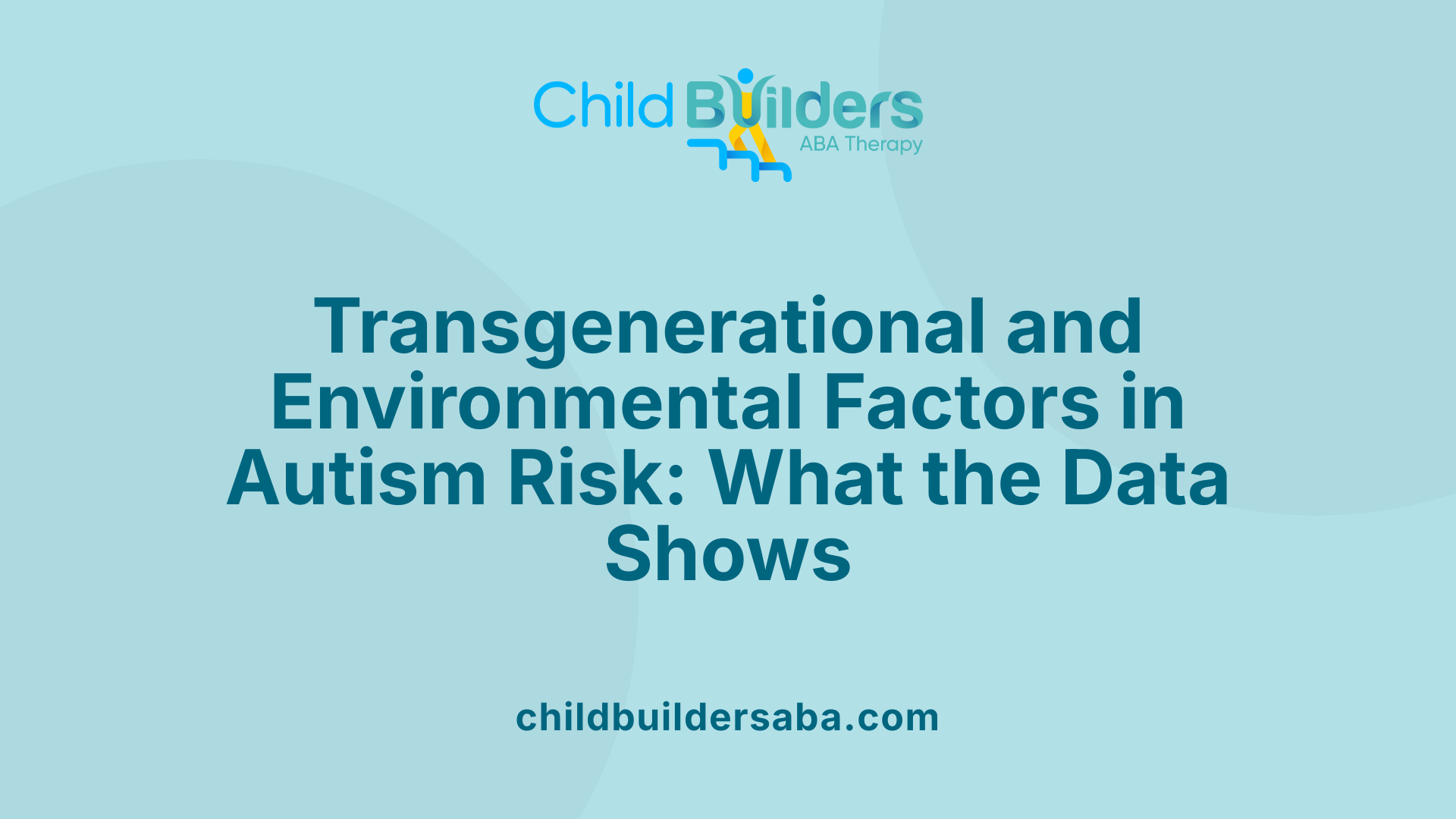
What is the relationship between parental age and autism risk?
Research consistently shows that older parental age, especially paternal age, is linked to an increased likelihood of autism spectrum disorder (ASD) in children. Multiple studies from different countries reveal that children of fathers over 40 to 55 years are significantly more likely to be diagnosed with autism compared to those with younger fathers. Specifically, children born to fathers in their 30s have a 1.6 times higher risk, while those with fathers over 45 have about a 75% higher chance, and men over 55 are four times more likely to have children with autism.
The primary explanation for this increased risk concerns the accumulation of spontaneous mutations in sperm as men age. These de novo mutations can contribute to neurodevelopmental conditions such as autism. Men produce new sperm throughout their lives, and with each year, the chances of mutations passing to offspring increase, raising the risk of ASD.
While maternal age also influences autism risk, its effect appears less direct and more complex. Some studies suggest a slight increase in risk after maternal age 30, whereas others indicate that younger maternal age might sometimes be associated with higher risks. Overall, the impact of maternal age isn't as clear-cut as paternal age, but both parents' ages can contribute to genetic and epigenetic changes affecting neurodevelopment.
The relationship between parental age and autism is dose-dependent, meaning the risk rises gradually as age increases. The overall contribution of increased parental age to the rising prevalence of autism is estimated to be around 1 to 5%. This suggests that while older parental age is an important factor, it doesn't fully explain the global increase in autism diagnoses.
Research also indicates that older paternal age correlates with higher cognitive functioning in children, whereas children of younger parents tend to score lower on early learning assessments, like the Mullen Scales of Early Learning. Furthermore, a large Danish study involving nearly 1.5 million children found that younger grandparents (aged 25-29 at the time of the parent's birth) might influence ASD risk, hinting at potential transgenerational effects.
These findings point toward a complex interplay of genetic mutations, epigenetic mechanisms, and possibly environmental influences. For example, the potential transmission of genetic changes across generations could play a role in ASD risk, especially when considering the age of grandparents. The Swedish population registry study emphasizes that both maternal and paternal ages, as well as grandparental ages, may contribute to ASD risk, possibly through cumulative genetic and environmental factors.
Environmental influences, such as exposures to toxins, stress, and lifestyle factors, might also interact with genetic predispositions, further affecting neurodevelopment. Although such environmental factors are less clearly defined in relation to parental age, they are critical areas for ongoing research.
In summary, increased parental age, particularly paternal age, shows a consistent association with higher autism risk, supported by evidence from worldwide studies. The mechanisms involved include genetic mutations accumulated over time and possibly epigenetic and environmental factors. Understanding these influences helps in assessing risks and guiding prospective parents about reproductive choices and early interventions.
| Factor | Age Range | Increased Risk | Possible Mechanism | Additional Notes |
|---|---|---|---|---|
| Paternal age | 30s | 1.6 times | De novo mutations accumulation | Risk increases steadily with age |
| Paternal age | 40s | 75% higher | Mutations and biological aging | Variability among individuals |
| Paternal age | Over 55 | 4 times | Extensive mutations and epigenetic changes | Significant but relatively rare |
| Maternal age | 30+ | Slight increase | Less clear, possible epigenetic factors | Less pronounced compared to paternal effects |
| Grandparental age | 25-29 | Higher risk | Transgenerational genetic effects | Evidence from Danish registry |
This ongoing body of research underscores that while older parental age is an important factor, it is part of a broader complex of genetic, epigenetic, and environmental influences shaping autism risk.
Age-Related Biological Changes and Their Impact on Autism
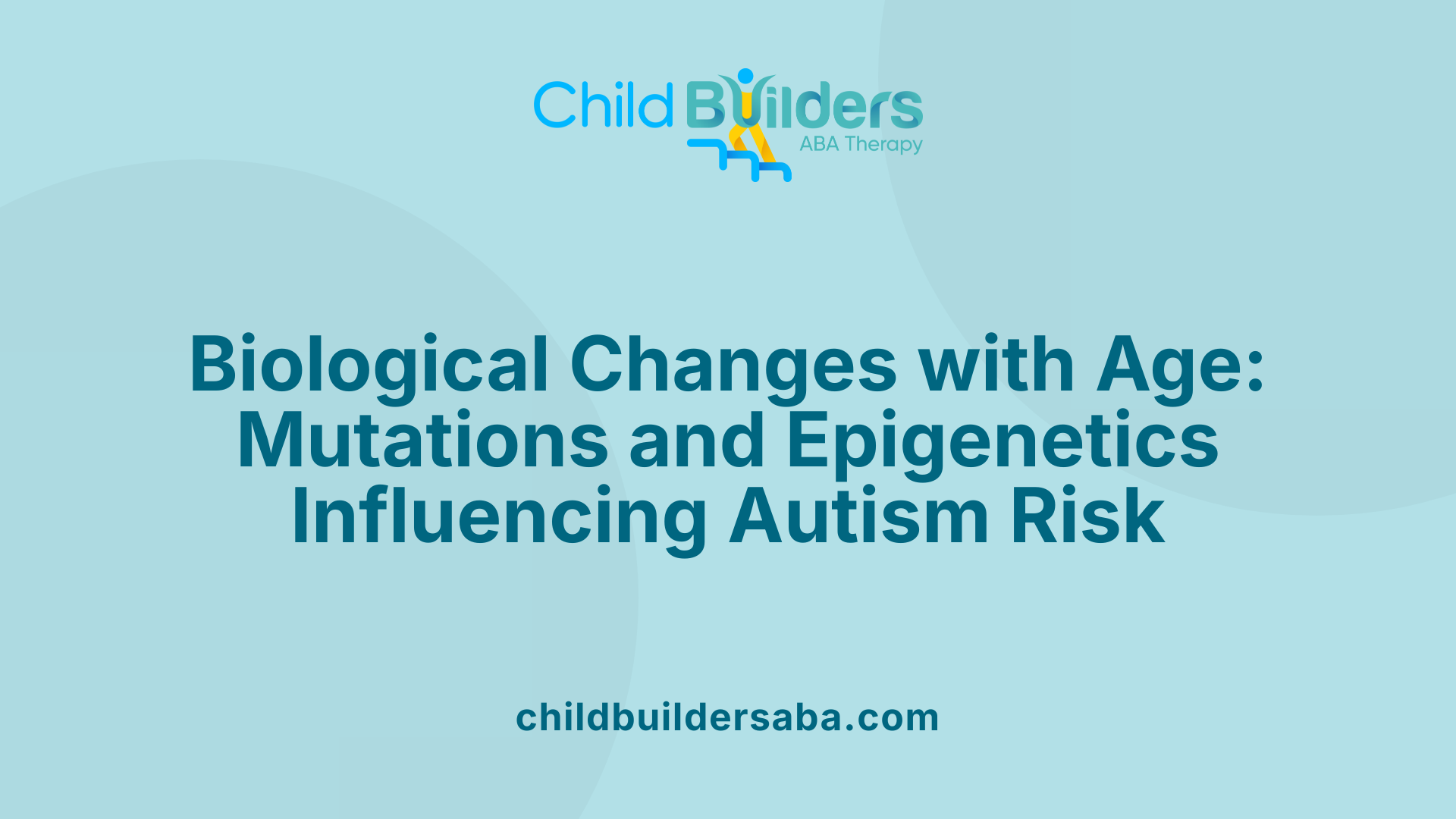
How does mutation accumulation in germ cells influence autism risk?
One of the primary reasons older paternal age is linked to higher autism risk is the accumulation of spontaneous mutations in sperm cells over time. Unlike women, who are born with all their eggs, men produce new sperm throughout their lives. With each round of cell division, tiny genetic changes, or mutations, can occur. These de novo mutations are more likely to be passed on as men age, increasing the chance of genetic alterations associated with autism.
Research indicates that de novo mutations accumulate faster in men than in women. This means that children born to fathers in their 40s or 50s are more likely to inherit new mutations in their DNA, which can contribute to neurodevelopmental disorders like autism. For instance, children of fathers over 45 have about a 75% higher chance of autism compared to those with fathers in their early 20s.
What role do epigenetic modifications play in age-related autism risks?
Beyond mutations, epigenetic changes—chemical modifications to DNA that affect gene expression without altering the DNA sequence—also play a role in autism risk associated with parental age. As men age, the pattern of epigenetic marks in sperm can change, potentially influencing how genes are expressed in the developing embryo.
These modifications can affect critical developmental pathways in the brain, potentially contributing to neurodevelopmental differences seen in autism. While the exact mechanisms are still under investigation, evidence suggests that both genetic mutations and epigenetic alterations work together, influencing the increased risk observed with older paternal and maternal ages.
What are the implications for reproductive health?
Understanding the biological impact of parental age is essential for reproductive planning and counseling. As studies show, children of older parents face higher risks—but these risks remain relatively small overall, with autism affecting roughly 1 in 100 children worldwide.
Healthcare providers can use this information to inform prospective parents about potential risks and consider genetic counseling options, especially if there is a family history of neurodevelopmental disorders. Also, advances in reproductive technologies might help mitigate some risks associated with advanced parental age.
How do these biological factors compare across different ages?
| Parental Age Group | Autism Risk Increase | Underlying Biological Factors | Notes |
|---|---|---|---|
| Under 30 | Baseline | Fewer mutations, fewer epigenetic shifts | Reference group |
| 30s | 1.6 times higher | Increasing accumulation of mutations and epigenetic changes | Higher risk compared to under 30 |
| 40s | About 6 times higher | Significant mutation accumulation, epigenetic shifts | Substantial increase |
| Over 45 | 75% higher odds | Elevated mutation load, epigenetic modifications | Most pronounced effect |
Understanding these patterns underscores the impact of biological aging on reproductive outcomes. Recognizing the roles of mutation accumulation and epigenetic modifications helps explain why the risk of autism varies with parental age, guiding future research and public health strategies.
Conclusion: Parental Age and Autism — A Multifaceted Interaction
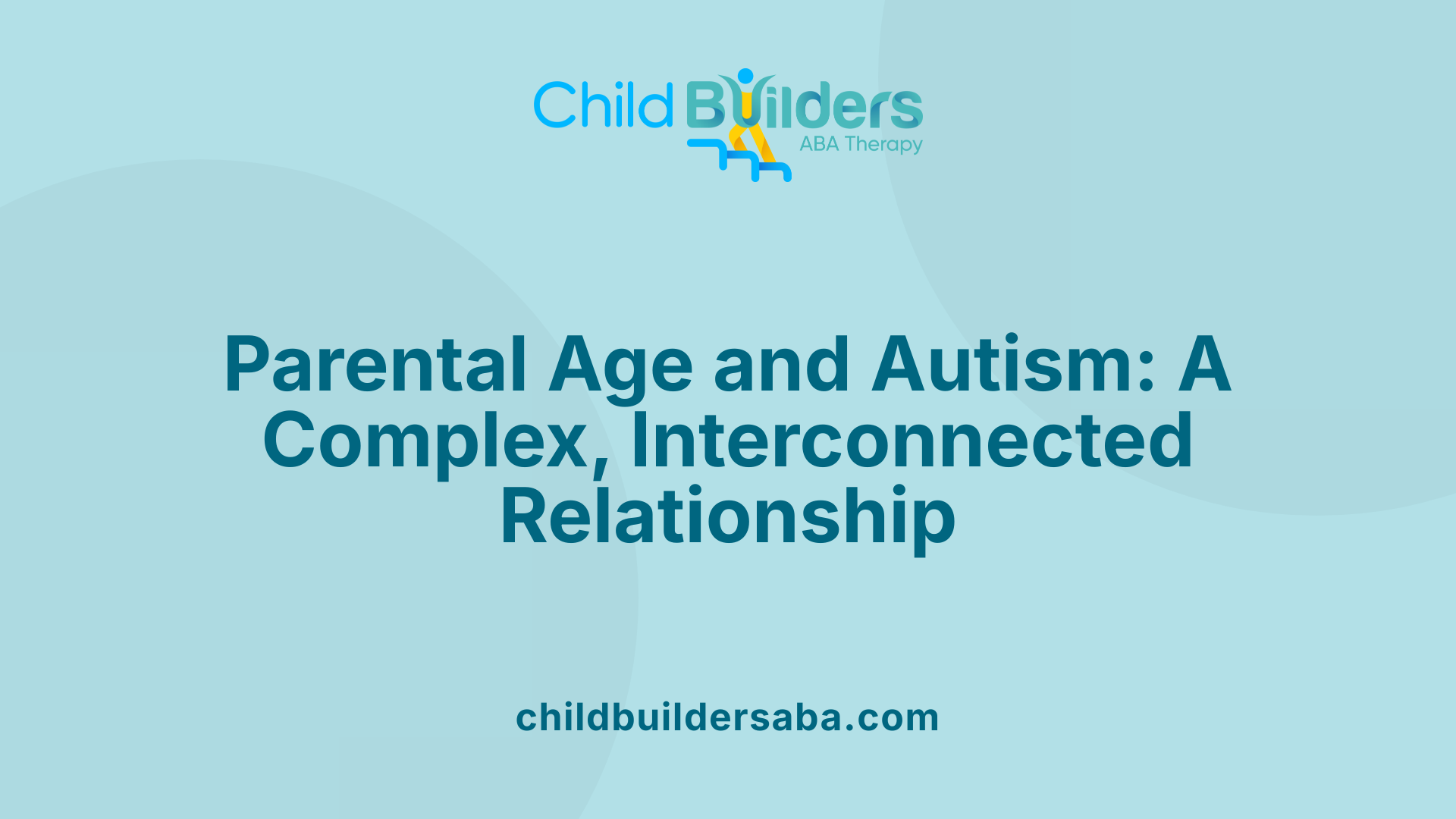
Are the odds of autism affected by age at conception?
Yes, the likelihood of autism in children is indeed influenced by parental age, with robust evidence pointing to both maternal and paternal ages playing critical roles.
Research indicates that children born to older mothers, especially those over 35, face a higher risk of autism. This risk increases progressively with advancing maternal age. For example, studies show that children of mothers in their 40s or 50s have approximately a 50% higher chance of being diagnosed with autism compared to children of younger mothers in their 20s.
On the paternal side, older fathers also contribute to increased risk. Men in their 40s and beyond are associated with a roughly sixfold increase in autism risk compared to men under 30. Studies involving large populations, such as Danish and Swedish registry data, support these findings, illustrating that paternal age over 45 can be linked to up to a fourfold increase in autism risk.
The biological explanation mainly centers around the accumulation of spontaneous mutations in sperm as men age, which increases the chance of passing on genetic variations associated with autism. Notably, de novo mutations—those not inherited from either parent—tend to occur more rapidly in men than in women, further explaining the paternal age effect.
Interestingly, some research also suggests a nuanced relationship with maternal age. Risk appears to stay relatively stable for mothers under 30, then increases significantly after 30. Moreover, an older maternal age is associated with a rise in ASD risk, especially after age 35.
Another layer to this interaction comes from studies examining multigenerational data, such as the Danish registry research, which highlights potential genetic and environmental influences transmitted across generations. Children with grandparents at specific younger ages at their parents’ birth, for instance, also show increased autism risk.
While parental age is an important factor, it accounts for only about 1 to 5% of the rise in autism prevalence, suggesting that other elements such as genetics, environmental exposures, and broader societal trends also contribute.
Overall, the consensus from numerous large-scale studies underscores that the odds of autism are indeed affected by age at conception, highlighting the complex biological and environmental interactions involved.
Implications for prospective parents
For those planning for children, understanding these risks can inform family planning decisions. While older parental age is associated with a higher risk, it is important to recognize that the overall probability remains relatively low, with autism affecting about 1 in 100 children worldwide.
Parents should be aware that early detection and intervention can significantly improve outcomes. Autism can be reliably diagnosed by age 2, often leading to intervention around age 4-5, which can enhance developmental and educational prospects.
Considering this, prospective parents, particularly those over 35 or 40, might discuss genetic counseling and prenatal screening options with healthcare providers to understand their specific risks.
Additionally, supporting early screening and intervention services and being aware of developmental milestones can be beneficial for all children, especially those at higher risk due to parental age.
Future research directions
Looking ahead, research is likely to focus on elucidating the biological mechanisms underlying the parental age effect, including the roles of genetic mutations, epigenetic changes, and environmental factors.
Large-scale genomic studies continue to deepen our understanding of how de novo mutations pass from older parents to their children, and how these mutations influence neurodevelopment.
Transgenerational studies, like those analyzing grandparental ages, suggest that future research will explore how genetic and environmental influences accumulate and potentially transmit risk across generations.
Furthermore, researchers aim to refine risk models by combining parental age data with genetic, environmental, and socioeconomic factors, providing more personalized risk assessments.
International collaborations and the integration of big data analytics serve as promising avenues for advancing our understanding of autism risk factors, ultimately helping to improve prevention and early intervention strategies.
| Aspect | Key Findings | Additional Notes |
|---|---|---|
| Parental Age Impact | Increased risk with higher age; paternal age > 40 associated with 50%+ risk increase, maternal age > 35 with rising risk | Biological mechanism includes mutation accumulation |
| Risk at Different Ages | Children of parents under 30 have lowest risk; those with parents over 45 show higher prevalence | Specific risk estimates vary by study |
| Multigenerational Factors | Younger grandparents and their influence on autism risks observed | Suggests genetic and environment transmission |
| Overall Prevalence | About 1 in 100 children affected globally; higher in boys | Gender and ethnicity impact rates |
| Early Detection and Intervention | Reliable diagnosis by age 2; intervention typically around age 4-5 | Critical for improving outcomes |
| Future Directions | Focus on genetic, epigenetic, environmental factors, and risk modeling | Aim to develop personalized prevention strategies |
Understanding the complex interplay between parental age and autism risk is crucial for healthcare providers, prospective parents, and researchers aiming to improve early detection, prevention, and intervention efforts.
Final Thoughts: Parental Age as a Factor in Autism Risk
Understanding the nuanced relationship between parental age and autism risk is vital for prospective parents and healthcare providers. While the association is evident, especially concerning paternal age due to genetic mutation accumulation, it accounts for only a small portion of the overall rise in autism prevalence. Future research focusing on epigenetic mechanisms, environmental interactions, and transgenerational effects may shed further light on this complex interplay, informing better reproductive health policies and personalized risk assessments.
References
- The link between parental age and autism, explained | The Transmitter
- Autism statistics and facts | Autism Speaks
- The Association Between Parental Age and Autism-Related ...
- Children Born to Older Parents Have 50% Higher Chance of Autism
- Child's Autism Risk Accelerates with Mother's Age Over 30
- The Heritability of Autism Spectrum Disorder - PMC
- The Heritability of Autism Spectrum Disorder - PubMed



.jpg)

































































































